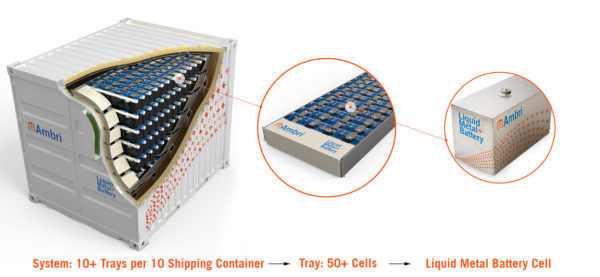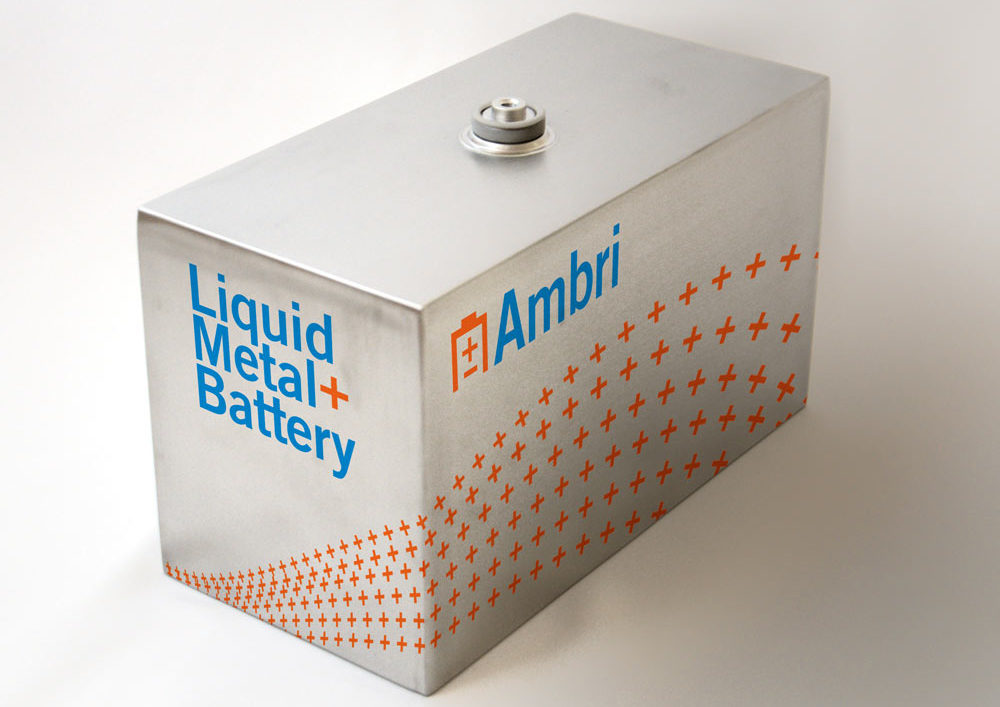Ambri, a developer of liquid-metal long-duration energy storage systems, announced it will partner with Colorado electric utility Xcel Energy on a demonstration project. The project will demonstrate Ambri’s calcium-antimony liquid metal batteries’ ability to interact with renewable energy.
Tribally owned economic development enterprise Grey Snow Management Solutions’ Solar Technology Acceleration (SolarTAC) will be the host site for the demonstration project. The SolarTAC was established to test renewable energy technologies in a real-world, grid-connected environments.
Ambri’s chemistry is being developed to meet the demands of large industrial energy customers, such as data centers. The company’s large-scale battery unit has a 250 kW / 1000 kWh capacity, DC efficiency of over 80% under a wide set of use cases, has a response time of less than 500 milliseconds, voltages between 550 V to 1150 V, and is housed in a 10-foot shipping container.

The containerized system holds shelves of cells, thermal management systems, a weatherproof outer enclosure, and a battery management system for applications that require high energy capacity, frequent cycling, long life and high efficiency.
“We are honored to be selected by Xcel Energy as they continue to drive towards a carbon-free future,” said Adam Briggs, chief commercial officer at Ambri.
Xcel Energy became the first utility in the United States to set a long-term goal of providing its customers zero-carbon electricity. The utility aims to be net-zero across electricity, heating, and transportation by 2050. Ambri’s technology is designed to perform in a wide range of environments, potentially making it the right fit for Xcel to effectively store and dispatch power in harsh Colorado weather conditions.
“We look forward to learning what (Ambri’s) technology can accomplish in a range of extreme environmental conditions as we look to build out the long-duration energy storage that will help us reach our carbon reduction goals,” said Alice Jackson, senior vice president and chief planning officer at Xcel Energy.
The SolarTAC has been owned and operated by MRI Global since 2011. It will test Ambri’s technology for one year. In addition to solar and energy storage, the site is used to test microgrid capabilities at the edge of the electric distribution system.
Late in 2020, Ambri agreed with TerraScale, a clean infrastructure design and development firm, to deliver 250 MWh of Ambri systems to TerraScale’s Energos Reno data center project. The site’s battery will be bolstered by a reported 500 MW of on-site renewable generation.
Last year, the MIT-spinoff announced that it achieved a $144 million funding round, led by Reliance New Energy Solar, Bill Gates-backed Paulson & Co., and Fortistar, Goehring & Rozencwajg Associates, Japan Energy Fund, and others. Ambri also entered into a long-term antimony supply agreement with Perpetua Resources. The agreement helps secure a domestic source of antimony for its supply chain.
Chemistry
The liquid metal battery is comprised of a liquid calcium alloy anode, a molten salt electrolyte, and a cathode comprised of solid particles of antimony, enabling the use of low-cost materials and a low number of steps in the cell assembly process.
The company said that the active materials in its cells reversibly alloy and de-alloy while charging and discharging. The electrolyte is thermodynamically stable with the electrodes, avoiding side reactions such as film-formation that can lead to performance degradation. The negative electrode is fully consumed when discharged, and reformed on every cycle, resulting in what the company said is a “highly repeatable process with no memory effect.”
Ambri said that following the funding round it now is able to scale for projects from 10 MWh to over 2 GWh around the globe, with durations ranging from 4 to 24 hours.
This content is protected by copyright and may not be reused. If you want to cooperate with us and would like to reuse some of our content, please contact: editors@pv-magazine.com.









Very smart design. Why any utility would pick a more expensive and fire pron chemistry (lithium ion) versus a fire resistant design, boarders on stupidity…especially when the installation is in the megawatt range.
Save the lighter/rarer elements for smaller/movable devices–cars, planes (taxi motors, etc), etc.
The articles on solar powered backed storage systems are a boon for the new upcoming entrepreneurs. They offer a wide range of options and opportunities for the business organizations which ultimately may usher in zero carbon emissions. The United nations sustainable development goals (SDGs) are yet to be fulfilled by the Member Countries of which zero carbon emissions technology is the most important one. I wish the author and the publisher to continue their efforts in bringing the most coveted information to the public.
With Regards